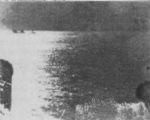- Author
- Prior, Russ
- Subjects
- History - WW2
- Tags
-
- RAN Ships
- HMAS Canberra I, HMAS Shropshire, HMAS Australia II, HMAS Sydney II
- Publication
- March 1995 edition of the Naval Historical Review (all rights reserved)
CANBERRA’S aircraft dropped warning bombs in the tanker’s wake. At 1720, an explosion occurred on the tanker well aft. The Walrus landed alongside and the observer, Lieutenant C. J. S. Malleson, R.N. stripped and swam to the sinking ship. He made a quick survey of the bridge area then signalled that she might be saved by a salvage party. The German prize crew of 17 officers and sailors and the original Chinese crew of 33 had taken to the boats which with the plane were brought alongside CANBERRA.
The other ship was also sinking when LEANDER appeared on the scene at 1838 and was requested to stand by. At 1850, the enemy ship sank and the survivors were taken aboard LEANDER.

As the tanker slowed to sink, Captain Farncomb ordered that her end be hastened by gunfire. Due to the close range, this was achieved by 4 inch shells.
Later it became known that the tanker was the KETTY BROVIG. She had been captured by the ATLANTIS earlier and had also recently refuelled ADMIRAL SCHEER and TANNENFELS. In addition, ATLANTIS had arranged for KETTY BROVIG to supply Italian submarines operating out of Italian Somaliland.
The other ship apprehended by CANBERRA was the 8,000 ton COBURG of the North German Lloyd Line. She was one of the ships that had to put to sea from Italian Somaliland due to the advance of the British forces. The Germans believed her loss was due to necessary instructions given to COBURG after she had left, being transmitted in an Italian code which had been broken by the British.
CANBERRA and LEANDER remained together during the night of the action. The next day LEANDER left at 1000 to search independently.
Anti-climax
CANBERRA’S Walrus aircraft was sent off for reconnaissance in the afternoon. Cloud cover was at 1,000 feet. Shortly before 1500 the Walrus increased speed and flew up into the clouds. Lieutenant Malleson, the Observer, handed a message to the telegraphist air-gunner Leading Seaman Hutchinson to transmit to CANBERRA informing of the sighting of an enemy pocket battleship with its bearing and distance. Hutchinson looked down through a break in the clouds and saw a single funnelled warship turning at high speed.
On receiving the message, CANBERRA broke W/T silence to signal C.-in-C. East Indies of the sighting and of Captain Farncomb’s plan to shadow the enemy until nightfall then attack with torpedoes. All British warships in the area were subsequently informed and headed for the position reported. AUSTRALIA was on her way home but altered course to join the hunt.
On board CANBERRA, the news of the sighting of a pocket battleship and that we were proceeding to engage it was announced over the ship’s broadcast system. Pandemonium broke out amongst the German prisoners in the cell flat. CANBERRA’S butcher, P.O. Karl Klein who could speak German fluently was on guard and quickly drew his revolver, climbed to the top of the mess deck ladder and threatened dire penalties in German and English. It was an unpleasant moment for him but he kept the Germans under control.
Others on board were apprehensive as we did not like our chances. ADMIRAL SCHEER had gained a fearsome reputation. After leaving Germany, she had attacked convoy HX84 of thirty seven ships from Halifax in the North Atlantic on 5th November 1940. Her 11 inch guns sank the escort AMC JERVIS BAY and five transports before night fell. The others escaped behind a smoke screen into the darkness. In comparison, CANBERRA was unarmoured and yesterday had fired 215 rounds of 8 inch at an enemy ship which had finally scuttled itself. About 20 minutes after Hutchinson in the aircraft had reported the sighting, he was handed another message cancelling the enemy report. The ship sighted was the LEANDER in an unexpected position. CANBERRA then informed the C.-in -C. East Indies and the search was called off. In CANBERRA, all relaxed a little and Captain Farncomb gained the nickname of “Fearless Frank”.
CANBERRA and LEANDER carried on searching in case any other enemy ship had arranged a rendezvous with the KETTY BROVIG. Nothing eventuated and both ships anchored at Port Louis, Mauritius on 8th March where the German prisoners of war and Norwegian and Chinese survivors were transferred to military authorities.




